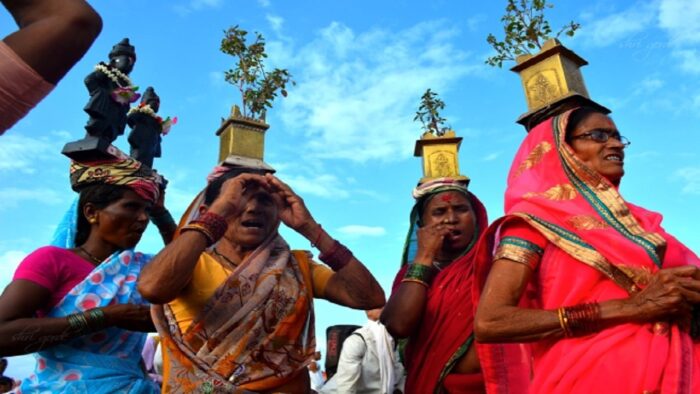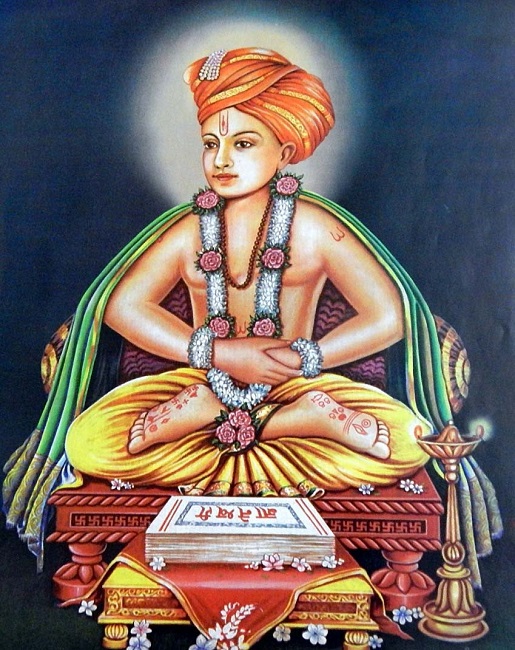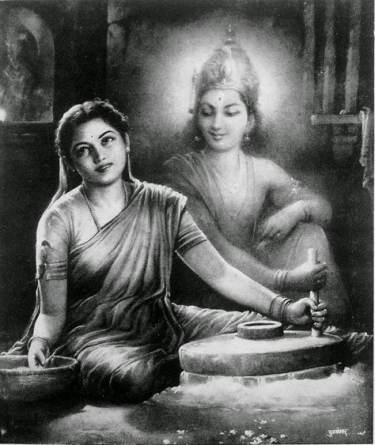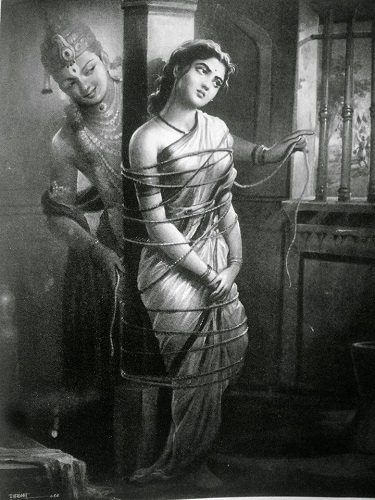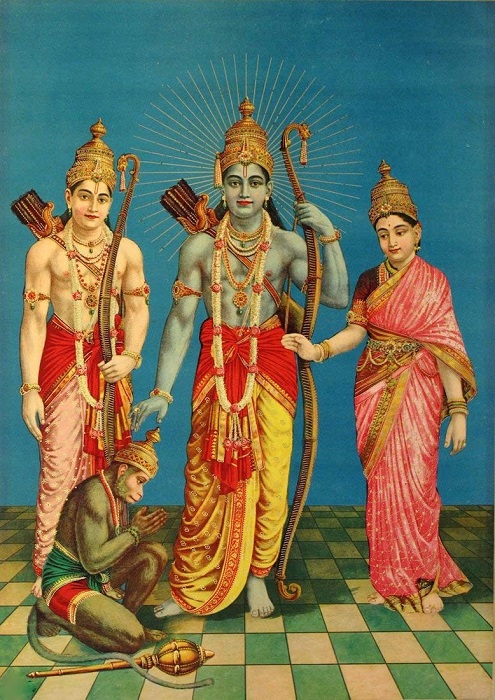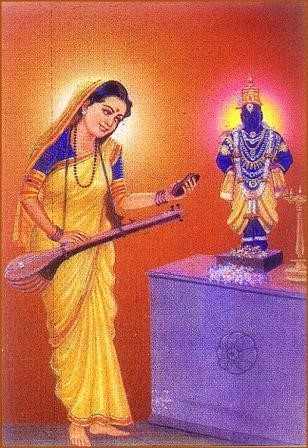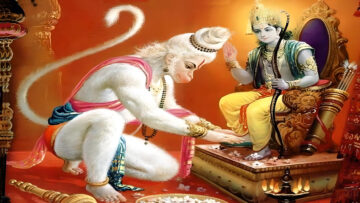Introduction
The state of Maharashtra has been gifted with a great lineage of saints who preached and spread the love towards God, knowledge of spirituality, and Bhakti to the masses through their simple yet impactful teachings. Gems such as the Dnyaneshwari by Dnyaneshwar Mauli, Eknathi Bhagwat by Sant Eknath Maharaj, Das Bodh and Manache Shlok by Samarth Ramdas Swami and the countless bhajans and ovees by various saints touched a chord in the hearts of many. The Warkari Sampraday and the Ramdasi Sampraday also find their roots here itself. These Sampradays, the work of these saints and their preaching held the Hindu thought and society together even in the face of a multitude of foreign invasions. It is no wonder that in such a fertile and enriching spiritual environment many women too were inspired to follow their quest for seeking and found their voice to talk about their overflowing love for the Lord. In many instances we see that it may have been a male saint who inspired a woman to follow suit or became her Guru showing her the path.
(Figure 1: Credit: Wikipedia.com – Sri Dyaneshwar Mauli)
To give examples, Muktabai was Dyaneshwar Mauli’s sister, Sant Janabai was a dasi at Naamdev Maharaj’s house and Sant Venabai was a disciple of Samarth Ramdas Swami. But having said that, it was finally upon the woman to find the inner courage and walk the entire path which was strewed with difficulties and not at all easy. In fact it was an uphill task as the then society was shackled by patriarchy, with unequal status to women, no education rights, and many other obstacles. To be path breakers and to mould the self in new clay, the women had to stand up against all odds even if there was a male member who may have been supportive of her spiritual endeavour. To have followed their heart’s desire to go on the spiritual path is one thing and to have been able to impact the society at large is another! These women saints not only bore hardships and faced resistance in some way or the other, they went on to be impactful and an inspiration to other women and to the society at large. It will not be a fallacy to say that till date these women saints and their works impact us, sometimes knowingly and sometimes unknowingly. Their works have not only impacted and shaped the spiritual environment of Maharashtra, but the by-product has been the rich and in-depth Marathi literature.
It is stated that Sant Kaviyatri, Mahadamba of the Mahanubhav panth was the ‘Adya Kavi’ of Marathi literature. After that Dnyaneshwar Mauli’s sister Sant Muktabai, Naamdev Maharaj’s Dasi Sant Janabai, Sant Kanhopatra, Tukaram Maharaj’s shishya Sant Bahinabai, Samarth Ramdas Swami’s shishya, Sant Venabai were all the luminous stars of Marathi literature. Historically, one can categorize the Sant Kaviyatris in four periods:
- Before Dyaneshwar Mauli or Mahanubhav literature period: Mahadamba, Kamalaisa, Umamba.
- Dynaneshwar Mauli and Sant Naamdev Maharaj’s period: Muktabai, Sant Janabai, Gonai, Raajai, Aaubai, Limbai, Soyrabai, Nirmala, Bhagubai and Sant Kanhopatra.
- Eknath Maharaj’s period: In this period there is no Sant Kaviyatri who can be traced.
- Tukaram Maharaj-Samarth Ramdas Swami’s period: [a] Warkari sampraday-Bahinabai, Premabai, Vithabai [b] Samarth or Ramdasi sampraday-Sant Venabai, Bayabai, Ambabai, Akkabai.
One observes that the work of these Sant Kaviyatris is inspired by their daily lives and grows with the same. Likewise the influence of their Gurus’ work is also seen in their work.
In the plethora of many luminous and brilliant stars of Maharashtra’s women saints, three are explored in depth in the forthcoming passages. Three saints who were:
[a] women and
[b] had some or the other huge challenge that she needed to overcome to find her way which led to God.
Sant Janabai was from the lower caste.
Sant Venabai was a child widow.
Sant Kanhopatra was born in the family of dancers and musicians.
Needless to say that these were huge hurdles that stood as big boulders in their chosen path. And even more needless to state that their names still ring in our ears, proof enough that they surpassed these obstacles to become part of our spiritual history impacting Hindu thought and inspiring Hindu society.
Method
To trace the journey of a saint, one can rely on historical accounts and chronicles, books by scholars, oral story traditions, and other historical materials such as remnants of the places they stayed in, their Samadhis if any and so forth. But the most insightful are the saint’s work itself, be it in the form of sonnets, ovees, bhajans, books and so forth. Thus the saint’s work becomes the backbone of the methodology applied to understand not just the spiritual impact of the saint but also trace other ramifications if possible such as political, religious, psychological, motivational and so forth.
- Sant Janabai
(Figure 2: Credit: Themillsarchive.com – Sant Janabai)
Life history
Much of Janabai’s history can be traced through her ovees and abhangs where she talks about her life and about working at Sant Naamdev Maharaj’s house and so forth.
Janabai was said to be born out of the prayers of her parents who were from the lower caste to Lord Vithala for a son. The Lord appeared in her father’s dreams and said that he would not have a son but a daughter who was Padmini in Krutayuga, Manthara in Tretayuga, Kubja in Dwaparayuga. Thus was born Sant Janabai. She was later sent to stay with Sant Naamdev’s father. It was an environment of Bhakti being a Warkari family. She worked as a maid in their house.
Janabai did all the menial work but was steadfast in her devotion to Lord Vithala. She would go to Pandharpur every Ashadi and Karthiki with Sant Naamdev. The immense influence of Sant Naamdev is seen in her works. In many of her abhangs, she calls herself as Namya’s (Sant Naamdev) Jani, and he indeed was her spiritual guru. In her abhangs there are references to her other contemporary saints too such as Dnyandev, Sopan, Chokha Mela, Muktabai, Nivruttinath and so forth pointing to the influence that they too had on her work.
The language of her poems is simple and lucid. Her abhangs are said to be equal in sweetness and lofty philosophies to that of Tukaram Maharaj. When one reads her ovees and abhangs one does feel that she had Lord Vithala’s grace or else how could a woman who was from a lower caste and belonging to a farmer’s family, deprived of equal status or education in the then societal structure, weave out such songs dipped with love and Bhakti?
There are references to certain mystical incidents too. It is said that the Lord Himself came to help her with all the household work which had become too much after a stormy night. She was once accused of theft and was about to be punished but the Lord saved her. The strength of her Bhakti and compassion in her poems is what makes her songs popular to this day in Maharashtra, after so many centuries.
He alone is the spiritual teacher, says Sant Janabai, who can show the Atman directly to our vision. Bhakti is indeed like a pit of cinders, or like a deep place in a river which is hard to approach. It is like a morsel of poison, or like the sharp edge of a sword. To be a real bhakta, says Sant Janabai, is as difficult as any of the above things.
Her work
A close look at some pieces of her work throws light on her bold, outspoken and honest approach even in her Bhakti.
डोईचा पदर आला खांद्यावरी |भरल्या बाजारी जाईन मी|
हातीं घेईन टाळ, खांद्यावरी वीणा |आता मज मना कोण करी ||
पंढरीच्या पेठें मांडियेले पाल | मनगटावर तेल घाला तुम्ही |
जनी म्हणे देवा , मी झाले येसवा | निघालें केशवा घर तुझें ||
(This ovee begins by her saying that the pallu that should be on my head is now on my shoulder. A bold statement indeed! She continues saying, “And that is how I will go to the crowded market place too. I will have the taal and veena in my hands and on my shoulder, who is going to stop me now?”)
नोवरीया संगे वऱ्हाडीया सोहळा |मांडे पुरणपोळ्या मिळे अन्न |
परीसाचेनी संगेंलोहो होय सोनें| तयाची भूषणे श्रीमंतासी ||
जनी म्हणे जोड झाली विठोबाची | दासी नामयाची म्हणोनिया |
(Here she talks about how the people who accompany the bride get sweets and other things to eat. She states that the stone ‘paras’ makes gold out of iron and rich people make ornaments out of it and showcase it on themselves. In the same way because I am Naamdev Maharaj’s dasi, I got to be one with Vithoba. One sees gratitude offered to her spiritual guru time and again for having led her on to the path of Bhakti to Lord Vithala)
झाडलोट करी जनी | केर भरी चक्रपाणी |
पाटी घेऊनिया शिरीं | नेऊनियां टाकी दुरी ||
ऐसा भक्तीसी भुलला | नीच कामे करुं लागला |
जनी म्हणे विठोबाला | काय उतराई होऊं तुला ||
(Here she says that if Jani is sweeping, the Lord comes and fills the dirt in the dustpan and on his head he takes it to throw it far away. You are doing menial work because of your love for my Bhakti. How can I ever repay this debt of yours? One can only imagine, the utter state of devotion and Bhakti that she had attained to be able to say that the Lord Himself does menial work for her sake)
भक्तिभावे वळे गा देव | महाराज पंढरिराव
पंढरीसी जावें | संतजनी भेटावे ||
भक्ती आहे ज्याचे चित्ती | त्याला पावतो निक्ष्चीती ||
भाव धरा मनीं | म्हणे नामयाची जनी ||
(Figure 3: Credit: Twitter.com – Sant Janabai with Vitthal)
(Go to Pandharpur, meet the saints. The Lord will surely bless the one who has Bhakti in his Chitta. Have the Bhakti bhava, says Namayachi Jani. The way she has ended many of her ovees, as Namayachi Jani, not only shows her single minded devotion to her spiritual guru but also indicates her honest and bold demeanour. Her urge to other people to follow suit so that they too can realise their spiritual goals comes across clearly).
खंडेराया तुज करितें नवस | मरुं देरे सासू खंडेराया |
सासू मेल्यावरी तुटेल आसरा | मरुं दे सासरा खंडेराया ||
सासरा मेलिया होईल आनंद | नणंद मरता होईन मोकळी |
जनी म्हणे खंडो अवघे मरू दे | एकटी राहुं दे पायापाशी ||
(She tells Khanderaya, let my mother-in-law die. Then my support system will go away. If father-in-law dies I will be happy. If sister-in-law dies I will get free. Let all die so that I can be alone at your feet. We see here the intense single point devotion of hers. She is actually asking the Lord to let her be alone so that she can remain at his feet).
Impact of Sant Janabai
A. Role model to other women
At the age when women were deprived of gaining knowledge, Jani gained knowledge, wisdom and a life immersed in Bhakti in the company of Sant Naamdev Maharaj and Dnyaneshwar Mauli. Her abhangs have meter, rhythm & everyday used words and similes which was easy on the lips of the womenfolk to sing while also attending to their daily nuances. Jani showed the way to women that despite being a dasi or a servant one could still carve one’s course.
In those times worship and spirituality were gender and caste determined or confined. These women saints gave a blow to the stereotype which has been a guiding force to this era too.
Her poems reflect not only the social life of 13th Century Maharashtra, but also the heart and emotions of women then. When women were expected to resign to fate of what marriage would bring for them, Jani stood for them as a woman to look up to, a woman not on a pedestal but amongst them, like them yet one who attained sainthood enduring her own life.
B. A Rajayogi indeed
If it can be said that Bhakti marg and Karma marg blend beautifully, it is nothing but Rajayoga. Jani was one to teach women that do every act as an offering to God and this tradition became a mantra in every household during her time and times to come.
What better epitome of proof for Jani’s Sainthood than Dnyaneshwar Mauli himself saying that Lord Vithala is not there in the gabhara, [sanctum sanctorum], he is with Jani, helping her in her household chores!
There is indeed a transition in her poems from Dvaita to Advaita, from Saguna to Nirguna, from Bhakti to Gnyaana and more evidently from Naamdev Dasi to Brahman.
C. Huge contribution to the Warkari sect and its spread and growth
In the spiritual democracy of the Warkari Sampraday, the contribution of Women saints like Jani is most significant. The equality of women, their independence in Warkari Sampraday all grew in the later years with the seeds sown by saints like Jani.
The abhanga written by Sant Naamdev Maharaj appropriately sums up Sant Janabai’s greatness:
जनीचे अभंग लिहित नारायण | करीत श्रवण साधु संत ||
धन्येतीची जनी , धन्यतिची भक्ती | संत नामदेव स्तुती करीतीसी||
Janiche Abhanga lihit Narayan | karit shravan sadhu sant |
Dhanyatechi jani, dhanyatichi Bhakti | Sant Naamdev Maharaj stuti karitisi ||
(He states, Jani’s abhangs are composed by God himself. All the saints listen to her religiously. Blessed is Jani, blessed is her devotion. Sant Naamdev Maharaj so praises her).
- Sant Venabai
(Figure 4: Credit: Sanatnprabhat.org – Sant Venabai)
Life History
Sant Venabai was born in a Brahmin family of the Deshpandes. She got married and widowed at the age of 10 itself. As a child, she was reclusive and quiet. It was her mother-in-law who encouraged her to read books. This is how she started the Eknathi Bhagawat Paarayan with full devotion. And soon she got engrossed in these readings.
The story of how she met Samarth Ramdas Swami is chronicled in detail. It is stated that once Samarth Ramdas Swami visited Miraj and came to the doorstep of Sant Venabai and asked for a glass of milk. This was refused by Sant Venabai’s mother-in-law which made Sant Venabai very sad.
He came again after a few days and saw little Vena reading the Eknathi Bhagawat. He asked if she understood what she was reading and little Vena replied, “To read with full Bhakti and dedication, that much I do understand. But how will I understand what is written and what has to be followed from this book?”
Thereafter Sant Venabai asked Samarth 25 questions, which he patiently replied. This is now a popular abhang, written by Samarth Ramdas Swami himself.
Soon after this meeting, she started getting restless and wanted to meet Samarth Ramdas Swami again. The words “Jai Jai Raghuveer Samarth” kept ringing in her ears all day and night.
A few days later Sant Venabai went to her mother’s house at Kolhapur. Samarth Ramdas Swami was staying there with his disciples and having daily sessions of Kirtan. She sought her parent’s permission and attended these kirtans daily in the evenings.
One day she fell at the feet of Samarth asking for his blessings and he gave her the Rama Mantra Upadesh. Both the houses did not like this development of widowed Sant Venabai. Accusations were hurled at Sant Venabai and the families as to how could a widowed Brahmin girl go after a Brahmin monk and rumours started to spread. Both her parents and her in-laws tried to dissuade her in a lot of ways and get her back home as they were subjected to too many taunts and accusations. However, Sant Venabai did not relent and refused to budge. She started doing Rama nama japa and kirtans. Soon Samarth Ramdas left for a pilgrimage asking Sant Venabai to continue with her spiritual practices and kirtans. Fed up with the constant taunts and accusations of people and having been socially ostracized, it is said that one day her own parents poisoned her.
Her body started to burn from within and she went inside a room and fell down. Her parents locked the door from outside. Sant Venabai prayed to Samarth and he appeared instantly relieving her of the poison. However, she was blackened because of the effect of poison to which Samarth Ramdas it seems commented that a good thing has happened. It is like a Neelakavach [Blue armor] given to you by Shri Ram himself for this arduous journey on the spiritual path. She thereafter resolved to be with Samarth Ramdas always, leaving her parents forever.
There is another story which is chronicled about Samarth Ramdas Swami and Venabai. Samarth Ramdas had a rule that no one should enter his room when he is eating. However once Sant Venabai opened the door as she had forgotten to serve something. There she saw a gigantic Hanuman eating along with Samarth Ramdas. Seeing that scene she fainted. Samarth Ramdas came out and ignored her but the shishyas told him to get her out of this state.
Samarth Ramdas said that she was not supposed to open the door so why did she do it then? One disciple of hers said, “If your children come running to you, do they become liable for punishment? “ Samarth Samarth Ramdas Swami then smiled and woke her up. It is also noteworthy that Sant Venabai was not the only one rare woman disciple. There were many of them though Sant Venabai was the one rare and popular shishya and she herself had her own disciples. People who came for darshan of Samarth sometimes asked questions and doubt, which most of the times were clarified and replied by Sant Venabai herself. The big disciple following Sant Venabai had made it such that many a times Samarth Ramdas Swami had to listen to what she said. Samarth Ramdas Swami encouraged her to do vyakhyan. She refused to head one of the Samarth Maths even at the insistence of Samarth Ramdas Swami. However later she relented and went on to be the Mathadipadi of Chafal Math and led it for almost 20 years with utter devotion.
Sant Venabai started getting more aloof and silent. She had started feeling the burden of her body, her life, her existence. She asked Samarth when will she go to Vaikunta, for which Samarth asked her as to what is the hurry? One Ekadashi day Samarth asked her to do a kirtan on Sitaswayamvar which she readily did. But before starting she asked her disciples to ready a funeral pyre shocking everyone. After the kirtan, she handed over her tambura to Samarth and bowed down, never to get up again.
Her work
Venabai has written extensively on Ramayana, on the essence of Vedanta, Sitaswayamvar, and lots of abhangs.
काळवेळ हे सफळ हित करा काही |
सर्व काळ सुख वेळ राम भजा भाई ||
काय जना कोण मना मानले हे सार |
राम वीण सर्व क्षीण दुख अनिवार ||
(She states here that do good use of your time. Do Ram bhajans always. This is the purpose of life. If people agree to this it is better, if Shri Ram naam is not there then there is suffering and dukha is for sure. One observes that naamsmaran was a very important part of her Bhakti and that she urged other too to follow).
बंद विमोचनराम।माझा बंद विमोचनराम।।
सकळही ऋषीमुनी भजती जयासी।एकचितो सुखधाम।।
सद्गुरु कृपया ओळखीला जो।कौसल्येचा राम।।
भावभक्तीच्या सुलभ साधनी।पुरवी सकळही काम।।
शरणही वेणा आत्मारामा।पावली पूर्णविराम।।
(She hails Shri Ram saying that all Rishis and Munis take his name and he is the one place of happiness. Due to the sadhguru I am able to recognise Kausalya’s son, Shri Ram. This is the easy method of bhav and Bhakti and completes all work. This Vena has come for sharan to you and I have attained complete peace. Purnaviram literally means full stop. One sees Venabai’s intense longing to reach the state of moksha and get out of the cycle of birth and death once and for all).
(Figure 5: Credit: Amazon.com –Sri Ram)
तुझी तुझी तुझी तुझी पावना राम
भावे अभावे कुभावे परि तुझी पावना राम
सुष्ट हो, दुष्ट हो, नष्ट हो, परि तुझी , पावना राम,
हीन दिन अपराधी म्हणे वेणी तरी तुझी पावना राम
(It is my desire to reach you, O my Ram. Whatever it may be, but I want to do so. I may be a sinner and yet I want to attain you, O my Ram).
ऐकोनीकरून अयोध्या राणा | मूर्तीच्या नयना अश्रु आले ||
ऐकोनी वाचा पतित पावना | कृपेचे पोषण वेणुवरी ||
(It is said that she said this after her poisoning episode, when she had become so weak that she had to be tied with the upparna [upper cloth that men use] to the pillar of the temple so that she could stand. She states that even Lord Ram’s murti is crying listening to her anguish and beseeching him that he should do krupa on her).
प्रभू लेश घेउनी विश्रांती घ्यावी |देहेतोवारी भक्ती तुझी घडावी ||
वेणी स्वामी ऐशा परीकौल दे रे | वदे राम लक्ष्मणा हे लिही रे ||
(Here she says, Lord Rama has come back after his exile and after defeating Ravana and has now ascended the throne. The people flock to see him and they can ask for a “kaul” or a wish from the king. Vena sings a long list of wishes which Rama approves of one by one and asks Lakshmana to take note of .The last wish is of our Venabai herself, as if she is also in the queue of visitors and asking for the Kaul, that she should always take the name of Lord Ram and Lakshmana. Once again one observes the importance on naamsmaran and japa).
Impact of Sant Venabai
A. Revolutionary Woman Saint
For a woman & that too a widow, to be a Mathadeesh of Chafal Math was revolutionary in itself. This step by Samarth Ramdas Swami kindled a sense of independence, a sense of pride & aspiration in the womenfolk. Sant Venabai went on to be Mathadeesh for almost two decades working dedicatedly and relentlessly becoming a revolutionary woman saint. Her greatness lies not only in her making people aware of the path of Ramadasi sampraday but also in awakening the people about the greatness of Sanatana Dharma and the country.
B. Great Teacher
Venabai had a huge number of disciples under her. She travelled from village to village and thus the impact of her abhangs, her sermons reached a lot of people, especially the village womenfolk. Women could relate better since her abhangs spoke not of lofty philosophies but about the daily aspirations and struggles of every householder.
Her treatise “Sita Swayamvar” has been held in high regard by both contemporary and later Sants. Her unique style of asking questions and answering them, made it very easy for the uneducated men and women to understand the nuances of epics & dharma.
- Sant Kanhopatra
(Figure 6: Credit: Braintordigitallibrary.com –Sant Kahnopatra)
Life history
Sant Kanhopatra was born in a dancer’s family and was the daughter of a prostitute named Shyaama living in the village Mangalvedhe near today’s Sangli. Sant Damaji was from this same village and Chokha Mela died of accident in this village itself. Kanhopatra was supposed to be the most beautiful in the entire region. This was the time of the Nawab’s rule.
When she grew up, she saw a group of Warkaris going from her village to Pandharpur. She joined them and left for Pandharpur instantly, asking whether the Lord will bless her as she comes from such a background? The answer of the Warkaris was that everyone is equal in the eyes of Lord Panduranga. She was so enamoured by this thought that off she went surrendering herself, doing Sharanagati to the Lord. And from then on she stayed there itself, doing bhajan poojan.
She became a great Warkari saint and walked her spiritual path with utter devotion to Lord Vithala. Sant Kanhopatra tells us that “It is bad pursuit to follow the path of sensual pleasure. I am verily an outcast. I do not know the rules of conduct. I only know how to approach thee in submission. Thou callest thyself the reliever of the fallen. Why dost thou not lift me up? Happy am I, that I have seen thy feet. Ajamela, Valmiki and even a courtesan have been lifted up by the name of God.” Sant Kanhopatra tells us that she wears the garland of God’s names.
It is chronicled that her beauty caught the attention of Bedar Badshah. He sent soldiers to get her to him. She asked them to wait and went inside the gabhara and became one with Lord Vithala. The Badshah himself came to Pandharpur to verify and became a different person falling at the feet of Lord Vithala.
Her work
A close look at some of Sant Kanhopatra’s work shows her utter devotion and her intense longing to reach God. Her own knowledge that she is at the lowest end in the then societal structure and hierarchy is observed time and again in her different ovees at the way she presents herself. But this in no way withholds her back in Bhakti and in her utter clarity of what she wants from her life. Her work also throws light on the fact that people from all walks of life were conversant, at least to fair extent, with the Itihasas and Puranas.
नामें दोष जळती | नामें पापी उद्धरती |
हे आले अनुभवा | सत्याजीवा प्रत्यया ||
नामें अपार तारिलें | नामें जीवनमुक्त केले |
कान्होपात्रा नाम घेतां | पायीं जडली तत्वतां ||
(One sees Sant Kanhopatra’s great faith in naam smaran in this ovee of hers where she states that naam smaran helps in burning away all doshas and people get uplifted. This is my own experience and this is my truth. Naam smaran has kept countless people afloat and one gets mukti from life. I myself take His name and my foundation is now based on this tatva).
दीन पतित अन्यायी, शरण आले विठाबाई |
मी तो आहे याति हीन, नकळे काही आचरण ||
मज अधिकार नाही, भेटी देई विठाबाई |
ठाव देई चरणापाशी | तुझी कान्होपात्रा दासी ||
(Kanhoptra tells the Lord that I am deen, having done many sins and I have come asking for sharan from you. I am from a low caste and hence I do not know how to behave, and I do not have any rights. So, O Lord, please meet me and give me shelter at your lotus feet, I am but your servant).
अगा वैकुंठीच्या राया | आगा विठ्ठल सखया |
अगा नारायणा | अगा वसुदेव नंदना ||
अगा पुंडलीक वरदा | अगा विष्णु तू गोविंदा |
अगा रखुमाईच्या कांता | कान्होपात्रा राखी आता ||
(She tells the Lord that you are the king of Vaikuntha calling him sakha, Vasudev’s son, Pundalik’s savior, and Rakhumai’s husband, now you only have to keep my honour).
जीवींचे जिवलगे माझे कृष्णाई कान्हाई | सावळे डोळसे करुणा येऊ दे काही ||
आला अपवाद याती संबंध लौकिक पाही | सावळे डोळसे करुणा येऊ दे काही ||
दीनोद्धारा ऐसे वेदशास्त्रे गर्जतो पाही | सावळे डोळसे करुणा येऊ दे काही ||
शरण कान्होपात्रा तुजला वेळोवेळा पाही | सावळे डोळसे करुणा येऊ दे काही ||
(Here she says that you are my life’s soulmate, O Kanha Krishna. O dark hued one, please feel karuna for me. I am of low caste. You are the one who saves the lowly ones. This is what vedas and shastras say. I have come seeking sharan from you, show mercy on me. Her marg of Bhakti seems to have been sharanagati, total surrender which keeps coming up in her different ovees).
शिव तो निवृत्ती | विष्णु ज्ञानदेव पाही ||
सोपान तो ब्रह्मा | मूळ माया मुक्ताबाई ||
चौदाशे वर्षाचे तप्तीतीर रहिवासी | गर्व हरविला चालविले भिंतीसी ||
धन्य कान्होपात्रा आजी झाली भाग्याची | भेटी झाली ज्ञानदेवाची म्हणूनिया ||
(Here she says Nivrrutinath is Lord Shiva, Dnyaneshwar Mauli is Lord Vishnu and Sopan is Lord Brahma. Muktabai is Maya. Mauli removed the pride of Changdev by making the wall move. Today I am blessed because today I have had the good fortune to have met Dnyaneshwar Mauli).
Impact of Sant Kanhopatra
A. Huge contribution to the Warkari Sect
Sant Kanhopatra is believed to have composed many abhangs. However, only thirty of them are available in the form of ovees. Out of these thirty, twenty three abhangs are included in the anthology of Warkari saints called Sakal Sant Gatha!
B. Achieved status of saint even without a Spiritual Guru
Sant Kanhopatra is the only woman saint who did not have a spiritual Guru, especially a male teacher. Yet even today her work finds place in the Sakal Sant Gatha and her name is included in the Maharashtra saints. This is no mean feat indeed and just goes to show how impactful her work is.
C. Voice of the woman from the marginalised society
Her poems were forceful and depict vividly her struggle and protest. They speak of ostracism, dejection and rejection of her womanhood as a normal lady looking forward to fulfil her dream of a happy married life. She was looked down upon because of her social status. She instead of asking the Lord to protect her invokes his pride and challenges him to keep his reputation intact as a “savior”.
Her poems are turbulent voices of womanhood coming out as a response to the hostility, the treatment meted out to them by their own community & villagers. All her poems show a longing for spirituality and her mystical experiences with saints and God.
D. Symbol of integration of extremes of a continuum
The sheer number of interesting possibilities steeped in ambivalence that Sant Kanhopatra offers to our imagination makes her an intriguing figure. She is a courtesan; she is a person who has renounced the material world. She is a poet, dancer, singer, musician, Bhaktin. She encompasses the Sant, the veshya, the ganika, the devadasi, the kalavantin, the nayakin, eluding a single label.
The boundaries between the dichotomies of sinner/saint, Sringara/Bhakti, marginalised/privileged, and sexual/spiritual appear blurred in her person. Underlying her identity is the fact that Bhakti acknowledges what her iconic figure symbolizes: the profane in the sacred, and the sacred in the profane.
Present impact of these women saints
A. Sowed the seed of Feminism or women empowerment
Feminism or women empowerment was not a popular concept during the period of Bhakti movement. However, slowly but surely the sheer strength of their individualism, the power of their Bhakti, their connect because of their compassion sowed the beeja for the future generations of women empowerment and a thirst for quest. This beeja helped these women saints to re-define the way of life by improving society, polity, relationships and beliefs. It required a great deal of inner strength, perseverance and clarity of thought for these women saints to defy all traditions and preconceptions. This feminine voice spread into the deep pockets of the villages. Women experienced for themselves how these women saints broke all barriers of caste, status, profession and stigma, unfazed. This has been a great learning for women of all times, especially today when women have to break the glass ceiling repeatedly to walk their path.
When these women were given turbulent environment, hurled with insults and abuses, what they let out is not cries and shouts of injustice but indifference and a complete focus on their own carved path. This is indeed what seems to have inspired so many of our today’s heroes who have stared adversity in its face and instead of complaining about their woes, have kept both their oars in water & continued their journey.
B. Continuing traditional values over centuries
The path each women saint carved was a niche in itself, albeit to reach the Ultimate Truth. The imagery in their abhangs were common household musings of family conflicts, missing spouse, their limitations, their suffocation, their desires et al leading them to learn, pick for themselves their own philosophy, their own ishta devata, write & set to tune their own abhangs, travel to teertha kshetras and most importantly spend time with other men and women in pilgrimages, a tradition set, preserved and nourished by the Warkari sampraday, till date.
C. Powerful and inspiring work
The fact that the ovees and bhajans of these three women saints are still in use speaks a lot on how powerful and impactful their work is. Following are proof that till date the work of these saints are inspiring and continues to find place not just in temple courtyards, or during festivals or cultural activities but in the present format of social media itself! One observes their influence on the present day society and Hindu thought.
Here are some sample videos of how today these abhangs of women saints are still popular, powerful and promising.
- Performance by a woman abhang performer – Shruthi Vishwanath
https://www.youtube.com/watch?v=tSaBEhTS0jc (on Sant Kanhopatra)
- Performance of woman kirtankar performing on the life of Sant Janabai (Smt. Smita tai Ajegavkar)
https://www.youtube.com/watch?v=aEQQOlQxHGs
D. Impact on other schools of thought
The doctrine of Bhakti which these saints of the Maratha school taught in their spiritual literature has been held in such high esteem by rationalistic writers like Prof. Patwardhan that one wonders how these could keep to their rationalism, while applauding the Bhakti doctrine of the saints, “if to discover the uncommon in the common , the unfamiliar in the familiar, the unknown in the known, the supernatural in the natural, the infinite in the finite, and the one in the many, be an element of the Vision Romantic, unmistakably we have it in the literature of the Bhakti school. Here is the romance of piety, of faith, of devotion, of the surrender of the human soul in the love, the light, and the life of the ultimate being. If all rationalism could be so eloquent of the merits of Bhakti, one would by all means be such a rationalist.
Discussion
We stay in times which are rife with conflicts and disharmony at the relationship level, family level, community level, societal level culminating at the global level itself. The main reason for this seems to be stemming from a deep sense of unease, unhappiness and discord that lies within each human being with the self itself. The Atman or the soul is restless as humans are trying to fulfil themselves at other levels such as physical, intellectual, emotional, personal but not the spiritual.
Thus though human beings are making great progress in fields of science, technology, art, humanities, artificial intelligence, health sciences and medical sciences and so forth, yet peace seems to elude humanity. The lifelong seeking continues but much of the time the seeking is directed or rather misdirected to more materialistic, monetary and career gains. Society at large makes one believe that materialistic, career, monetary pursuits and pursuits of name and fame are of utmost importance and success many a times gets defined using yardsticks based on the same. Thus it is very easy to get carried away in this herd mentality and believe that we are a failure if we have not achieved the same, a malady that makes many suffer albeit irrationally and unnecessarily.
As the spiritual anchor is absent, the realisation and awareness does not dawn that rather than getting stuck in the goals that society deems correct for one self, one should be looking at existential questions such as what is the purpose of my life and what is that I should pursue as the larger goal in this human birth of mine. Thus alignment is not towards the authentic core of the individual but the attempt is to align oneself to the societal norms and structures laid down by society, many a times the attempt proving futile and frustrating to the individual. This then can lead to self esteem issues, feelings of inadequacy, isolation and alienation and at times lead to grave psychological issues too. This is true in the case of both men and women. In this the women have further challenges of living up to the unrealistic expectations of managing home and career both seamlessly, stretching their coping mechanisms to the hilt.
A whole generation is caught up in this self defeating and erroneous processing of life’s priorities and purpose and ending up thinking of the self as losers. If we want to save further generations from this self sabotage, they need to be introduced to the life of adhyatma – spirituality now, on an urgent basis.
The teachings of our saints need to be once again assimilated seamlessly in the daily routines and customs. Daily prayers, chanting shlokas and mantras, singing bhajans, listening to kirtans, reading our scriptures to understand them has to be incorporated at the family level to lay down the foundation at home itself. Just as charity begins at home, so does spirituality and spiritual lessons. This then needs to be taken ahead at the community level. Here the teachings of our saints could help one realise their own authentic core, know their own purpose in life and help in becoming a spiritual anchor thus helping them stay true to their values and paving the way to spiritual growth and development.
The life of our saints and as delineated in detail here the life of Janabai, Venabai and Kanhopatra, their work and their impact on the then Hindu society and the impact that they have on our present times brings to the fore the sheer importance of the role that Bhakti plays in our lives. They preached the loftiness of Bhakti and love of the Lord through their scintillating sonnets, illumining couplets and brilliant compositions. It helps one realise that the anchor that we all need to stay centered and grounded in life is to have devotion and faith in the Lord.
If this refined knowledge can be adopted from antiquity and assimilated to modern modes of living one might expect less of strife in one’s lives, and move towards true self actualization and Atmabodh!
References
- Vivekananda Kendra Patrika (1977). Religious Philosophies of Indian Origin, Mysticism , Volume 6, Number 2, Distinctive Cultural Magazine of India, Vivekananda Kendra, Kanyakumari
- Madhav Kanitkar(2002). Dainandin Sakal Santgaatha, Nivad and Nirupan, Diamond Publications, Pune. ISBN 978-818483-095-8
- Majushri Gokhale (2020). Samarpan. Sant Kanhopatra. Mehta Publishing House, Pune. ISBN 9789353174637
- Majushri Gokhale (2012). Omkarachi Rekh, Jana. Sant Janabai. Mehta Publishing House, Pune. ISBN 9788184983487
- M K Yadav (2012) Marathi Sant Kavayitri, (Samiksha – Sandarbha), Smita Printers, Pune. ISBN 978-81-89634-62-9
- Jagannath Raghnath Azgaonkar (1939) Maharashtra Sant- Kavayitri, Bharat Gaurav Granthalay, Mumbai.
- Mumbai Marathi Grantha Sangrahalay (1952) Maharashtriya Sant – Vandmayva Jeevan, Atre Printing Press, Mumbai.
- M L Jadhav, (2018), Voices of Marginality: The poetry of Saint Kanhopatra and Janabai, Research Direction UGC Sr No 45489, Shivaji University, Kolhapur.
- Preeti Oza (2021) Roots of Feminist fervour: Women in Bhakti Movement, DOI:10.13140/RG.2.2.18187.41763, Mumbai. https://www.researchgate.net/publication/353380848_Roots_of_Feminist_Fervour_Women_in_Bhakti_Movement
Feature Image Credit : shrigorde.wordpress.com
Watch video presentation of the above paper here:
Disclaimer: The opinions expressed in this article belong to the author. Indic Today is neither responsible nor liable for the accuracy, completeness, suitability, or validity of any information in the article.

